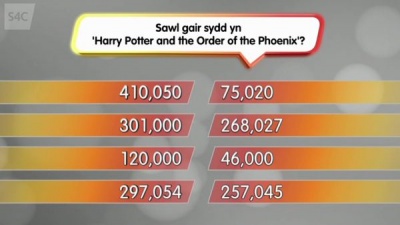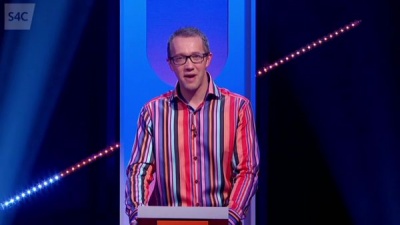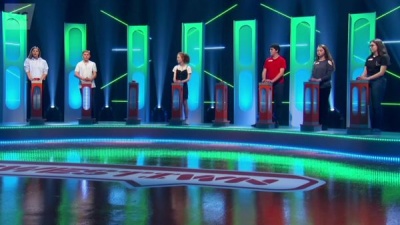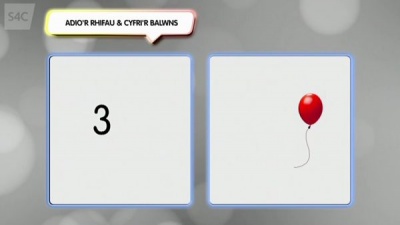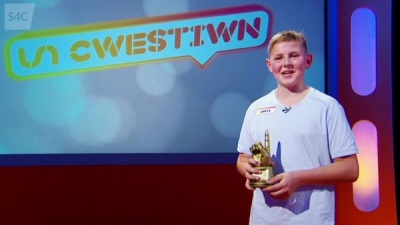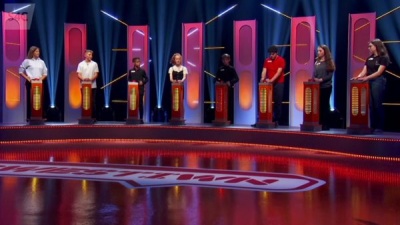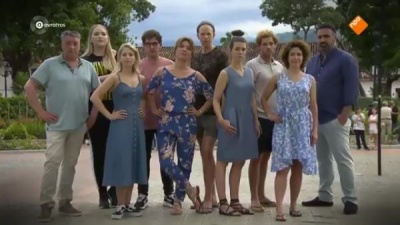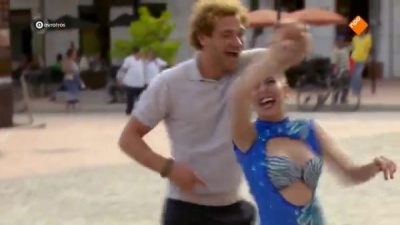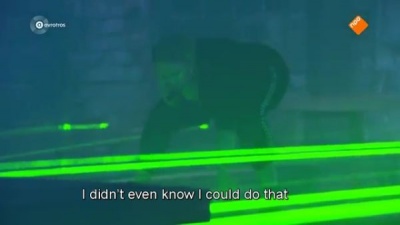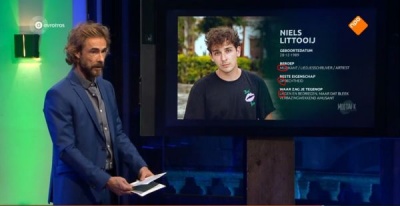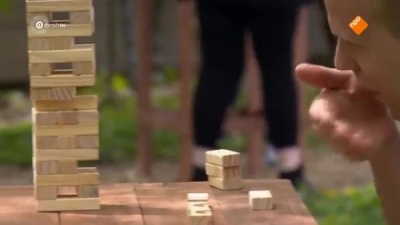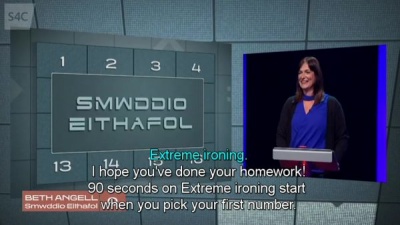Weaver's Week 2019-02-03
Last week | Weaver's Week Index | Next week
Eight school-age children. Twenty-four coloured lights. A million words. And no questions... except one.
Contents |
Un Cwestiwn
Boom Plant for S4C, from 8 January
Call us pedants, but when a show is called "One Question", we expect it to contain precisely one question. Plenty of other things that aren't questions, but the count of questions might well be limited to one.
Iwan Griffiths is our host, and the first thing he does is read out the one question. How many words are there in "Harry Potter and the Order of the Phoenix"? And he reads out eight possible answers.
Then Iwan introduces us to the eight contestants, all children of around 13 years. Yep, it's another entry in S4C's Stwnsh block. And he shows us the trophy, a hand folded to leave one finger sticking up. One finger for "one question", presumably.
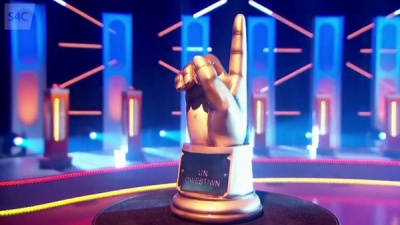 Must not be put beneath the Pigo dy Drwyn trophy.
Must not be put beneath the Pigo dy Drwyn trophy.
We'll sit through four "tasks" during the show, and whittle our eight contenders down to just one. To do this, we'll, er, ask questions. But not the One Question, we'll ask random general knowledge questions. This slightly undermines the premise of the entire show, because "One Question" has somewhat more than one question. Anyway.
Task One seems like a good place to begin. It's a general knowledge question with three possible answers. "On which continent would you find giraffes in the wild? Europe, Asia, Africa." Get it right and the contestant has got it right, get it wrong and they've not got it right.
At this point, we confess to a major problem. We don't fully understand how Task One affects the rest of the game. Iwan might explain it in Welsh, but Un Cwestiwn doesn't have subtitles to translate into English, and this column's Welsh isn't good enough to follow the explanation.
Task Two follows next. It's a mixture of two types of puzzle – and puzzle is the word. One puzzle asks the contenders to recall a sequence of colours. The other asks them to unscramble Welsh words from syllables. All of the puzzles are on the buzzers, and only the first player to buzz is able to answer.
And only the first six players to give a correct answer will remain in the game. We think that anyone who makes an error is frozen out of the next two questions (so get a colour sequence wrong, and you're out of the next word and the next colours), and two errors removes you from the game entirely. But we could be misinterpreting what happens on screen.
Task Three is a categories-and-control quiz. Iwan asks general knowledge questions on the buzzer. Get the question right and you have a pick from the categories board. There are four categories, each has just two questions behind it. To qualify for the next phase, a player must get a starter question right, and solve a question in their chosen category. Fail in either, and the player's frozen out of the next starter. (We think. Could be wrong.)
Just three players are allowed to qualify from Task Three, the first three to answer their category questions correctly. Again, two errors in this round will eliminate someone from the game.
So we're up to Task Four, and a return to the puzzle questions. This one is properly vicious. All you've got to do is add up the numbers that appear on the left-hand side of the screen, and count how many of a certain object appear on the right-hand side of the screen. Even though we're lost at this task, we appreciate how it makes for tense television.
Once again, all puzzles are on the buzzer, and the first player to give three correct solutions wins the game. The winner – and only the winner – gets to answer the titular One Question.
Throughout the game, Iwan has removed some of the incorrect answers from the One Question. By the time the winner faces it, just four remain. Their first task is to remove one of the incorrect answers, and then to give the One True Answer to the One Question. Only the One True Answer will earn the one One Question trophy.
Now, it's fair to say that we've a few problems with Un Cwestiwn. A large part of this is that we don't understand the format precisely; in particular, it's not clear what advantage comes from solving Task One.
But there are little presentation weaknesses. Just from looking, it's not clear who is in play at any time. Suppose we're in the middle of Task Two: three players have gone through, and one has been wallied out of the current question. Who's available to answer the question? It's not clear. They could use symbols on the podium, they could use lights, they don't do anything to help us out.
Ultimately, a quiz is as good as its questions. The general knowledge questions pose a reasonable challenge to children of about 13, and the puzzle problems are interesting in their own right. As with Brightest Family, we'd love for them to mix it up a little more, and the final task would benefit from variety between shows.
Is Un Cwestiwn worth a watch? Absolutely. Are we able to sing its praises and sell it around the world? No. More on that story in a future Week.
Wie is de Mol?
AVROTROS, shown on NPO1 and BVN.tv from 5 January
We've been watching the Nederlands show Wie is de Mol. It's freely available around the world via Dutch-language broadcaster bvn.tv, and there might be some subtitled videos floating around ("widm english subs" feels like a good search term). Yes, we've seen it on these shores; The Mole was a cult hit on Channel 5 in 2001. But that was then, and this is a generation later.
The basic plot is simple. Ten people are taken to a remote place (in this series: Colombia) and given assorted tasks. Success is rewarded with cash. But one of the ten is a mole, their job is to sabotage the tasks so that not much money is won. Every episode, there's a test, and the person who knows least about the mole is off the show. Winner of the final test keeps all the money.
After four episodes, the team could have won €LOTS. Instead, they've won €PEANUTS. Some of this is a sabotage cooked up between the mole and the producers. Some of it is the players just being completely useless.
Wie is de Mol has had some visual challenges. In the opening edition, our candidates went to a market square, where they all took part in some salsa dancing. Mmm, saucy. The challenge was very simple: find the person you danced with. The purpose of a television entertainment is to be entertaining, even if you're not playing along, and this challenge worked really well.
Others were more complex: still in the opening edition, our lab rats were put on cycles and sent round some churches. Instructions were given to people from screens on the back of the person in front's cycle, and if anyone stopped cycling their instructions would get out of time. It's hideously complicated to explain, it was hideously complicated to watch, and made for some tedious television.
Every show has its go-to tropes – challenges that are associated with the programme. The Crystal Maze has Adam Buxton In A Jar, Raven has the Leap of Faith, Fort Boyard has its tigers. Wie is de Mol has its laser room; in this year's incarnation, don't break the lasers, don't touch the floor, and don't stay in the room too long. It's a visual treat, and this year everyone got to go in. Some came out with money. Did the others trip through clumsiness or through malice?
Some of the challenges advance the show's storylines. In "Waiting Room", groups of candidates were shown footage of themselves discussing the "jokers" and "exemptions" found within the game. Each joker turns a wrong answer into a right one. Each exemption allows a player to skip a test and progress to the next show. But there's a "black exemption", which will nullify all other jokers and exemptions played during that show, so everyone competes on their actual merits.
In a later episode, head-to-head Jenga was played, with blocks in the stack marked to build up a picture of jokers – some got one joker, some grabbed a full three.
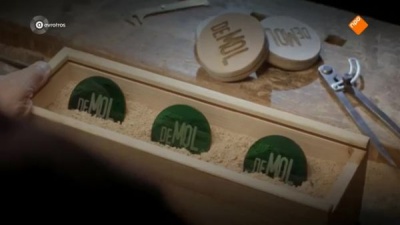 Alles is hand gemaakt en gesneden in hout. Dit kan een aanwijzing zijn. (Everything is handmade and carved in wood. This might be a clue.)
Alles is hand gemaakt en gesneden in hout. Dit kan een aanwijzing zijn. (Everything is handmade and carved in wood. This might be a clue.)
After four episodes, it's clear that the team is struggling. Morale is low, the cashpot contains very little, and someone has been messing around with people's jokers. We wonder: has any candidate ever ragequit the show before?
Speculation
The title translates as "who is the mole", and it would be remiss of us not to offer ideas. Even before anyone had seen the first episode, Niels Litooij was the favourite suspect, his description in the introduction show began with the letters M-O-L.
Merel Westrijk always seems to be in the wrong place at the wrong time: she helped to drop a coffin in the opening challenge, she was early into the laser challenge and might have fiddled with other people's piles.
Three eliminations have removed Evi Hanssen, Nikkie de Jaeger, and Evelien de Bruijn. Nikkie said that Evi was her prime suspect, Evelien intimated that she suspected Nikkie. Can we conclude that the mole hasn't been working much with these people?
At this point (and we're writing before we see episode 5), our suspicion points towards Jamie Trenité or Merel Westrijk. Both have made some elementary errors, Jamie predicted a poor outcome on a challenge to hang coloured clothes (so did Evelien de Bruijn, but she's been eliminated). In this week's balcony puzzle, Merel finds her balcony, then leaves it and appears on one she knows is wrong. Both seem to be in the place we'd expect a low-key saboteur to be.
More molactivite next month.
Mastermind Update
Heats 13-15
Carole Stead won heat 13, racking up 30 points with specialist questions on the Reign of Akhenaten, an ancient Egyptian hieroglyph. Amit De made it to 26 points with Albert Einstein, and both Marion Whitehead ("Hamish Macbeth" books) and Richard Pyne (Joseph Paxton) had a score above a score.
Hamish Cameron might be the most regular visitor to the Mastermind chair, comments at the Life After Mastermind blog reckon this was his thirteenth appearance. Wasn't unlucky at all, Hamish won the heat scoring 27 on John Knox. There was a Perfect Round in this show, Susannah Croft hit the Novels of Sarah Waters out of the park, and finished with 25 points (3 passes, so unlikely to return as a high-scoring loser). No shame on Alex Patel (Battle of Stalingrad) nor Philip Dubois (History of the World Cup).
Nicholas Young won last Friday's heat, taking John Buchan as a specialist subject. He followed the rest of the series' high standard of preparation, and rattled up 26 points. Hyder Al Hassani (Arnold Schwarzenegger), Liz Woodcock (David Hockney) and Conor McMahon (Tony Benn) were less well-prepared, and suffered from stage fright and nerves. With regret, we must note that Conor McMahon scored 7 points across two rounds, one of the lowest in the current format.
More Mastermind in four weeks.
This Week and Next
TV Highlight of the Week. Sports quiz Y Ras had a short celebrity series. One of the rounds asks people to nominate a specialist sports subject. The result was a television first.
Jeremy Hardy, the wry observer of life, has died aged 57. A stand-up comedian who described himself as a "pessimistic soul", Jeremy was doing stand-up in mid-80s London, a particularly fertile time for new talent. He won the Edinburgh Festival's comedy award in 1988, and after doing "Unnatural Acts" with his wife Kit Hollerbach, he gained his own radio series "Jeremy Hardy Speaks to the Nation".
Jeremy remained a regular voice on Radio 4, a regular on The News Quiz and brought his unique singing lack-of-talents to I'm Sorry I Haven't a Clue. On television, he did turns on Mock the Week, worked on If I Ruled the World... with Graeme Garden, and many more cameo roles. A kind soul in The Guardian wrote of him, "In an ideal world, Jeremy Hardy would be extremely famous, but an ideal world would leave him without most of his best material."
Bring on the Face The BBC is to make a pilot episode of The Wall Face au Mur. The EndemolShine format involves balls falling down a really tall wall, and ultimately a choice between a small guaranteed prize and a risky large prize. This column reviewed The Wall in 2017. Danny Dyer will host the not-for-broadcast pilot, to be filmed on the set of The Wall Wygraj marzenia in Warsaw.
BARB ratings in the week to 20 January.
- Call the Midwife remains television's biggest show (BBC1, Sun, 9.15m). Dancing on Ice slips a little, but is still the top game (ITV, Sun, 6.25m).
- Also falling: BBC The Voice (ITV, Sat, 5.9m) and The Greatest Dancer (BBC1, Sat, 4.7m). The Chase has another huge number (ITV, Fri, 4.3m), and Would I Lie to You breaks 4 million (BBC1, Fri).
- The only Saturday show to increase its ratings: Stephen Mulhern's Celebrity Catchphrase (ITV, 3.95m), so clearly the schedule needs even more Stephen Mulhern. Is that possible?
- Top on Channel 4 was SAS Who Dares Wins (Sun, 3.35m); if you don't class that as a game show, Hunted (Thu, 2.3), and both shows tick up from last week. BBC2 was led by University Challenge, its first win over Only Connect in some months (Mon, 2.295m to 2.292m). Catsdown (C4, Fri, 1.9m) and Mastermind (BBC2, Fri, 1.55m) both scored well.
- Top digital shows: A League of Their Own Eurotrip (The Satellite Channel, Thu, 875,000), Celebrity Coach Trip Road to Barcelona (E4, Tue, 695,000), and Hell's Kitchen (ITV2, Tue, 640,000). Great week for The Chase on the Challenge channel, pulling 255,000 on Sunday afternoon.
This week, Davina McCall returns with another run of This Time Next Year (ITV, Tue). On Radio 4, Just a Minute begins its latest series (Mon). They'll hope to find some talent in Salford as Eurovision You Decide (BBC2, Fri) takes place. David Jensen and Isla St Clair pop up on Pointless Celebrities (BBC1, Sat).
Photo credits: Boom Plant, AVROTROS, Hoi Polloi.
To have Weaver's Week emailed to you on publication day, receive our exclusive TV roundup of the game shows in the week ahead, and chat to other ukgameshows.com readers, sign up to our Yahoo! Group.


